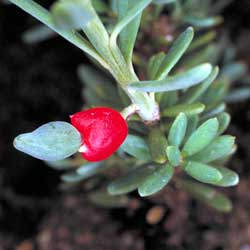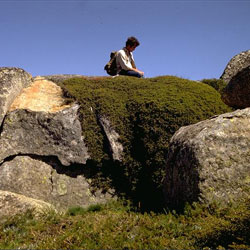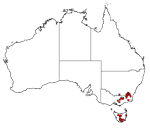Podocarpus lawrencei
 female cone or fruit |
 male cones |
 Clinging to alpine boulders |
Mountain plum pine
Podocarpus lawrencei is a medium to large spreading shrub which would be ideal as a feature plant and groundcover in a rockery. It also occurs as a tree to 15 m so care should be taken to ensure that the desired form is being purchased. This article will refer to the shrubby, alpine form for its value as a garden plant. As it is the only conifer occurring above the treeline in our alpine regions and because it has an attractive, red fruiting body, its common name is the Mountain Plum Pine.
 The
Mountain Plum Pine is one of Australia’s few native conifers from a plant
family which has existed in the southern hemisphere since the time of the super-continent
Gondwana (180 my). The natural habitat is low heath in the alpine areas of south-eastern
Australia, including Tasmania.
The
Mountain Plum Pine is one of Australia’s few native conifers from a plant
family which has existed in the southern hemisphere since the time of the super-continent
Gondwana (180 my). The natural habitat is low heath in the alpine areas of south-eastern
Australia, including Tasmania.
An adaptation to the harsh alpine environment is its habit of clinging to and taking the form of exposed granite boulders. This enables the plant to maximize the light and warmth available for growth during the snow free season. It is the longest lived alpine species but, in that harsh environment, the growth rate is very slow. A specimen from near Mt Kosciuszko was found to be 170 years old but had a trunk diameter of only 6 cm.
The leaves are narrow and about 1.5 cm long. They are crowded, thick and dark green with a prominent mid-rib beneath. They give the plant a resinous pine-like aroma and form a dark background to contrast the bright cones and fruit.
Unusually, for a conifer, the sexes are on different plants. The cones on the male plants are an attractive pink-purplish colour and are about 1 cm long in small clusters.
On the female plant the reproductive structure does not resemble cones. When ripe, it develops into a bright red, succulent berry-like structure, above which is attached a hard green seed. The male cones in spring and the red ‘fruit’ in summer each stand out against the dark green foliage.
Another attractive feature of the plant in its natural state is the existence of bare limbs among the mat of growth. These are a twisted, gnarled and weathered to a whitish-grey to contrast with the other colours and with the rock chosen as a substrate.
Propagation of the plant is by cuttings and this is essential to retain the chosen form and sex. It can be transplanted while small and can be purchased as tubestock. In the Australian National Botanic Garden the Mountain Plum Pine is used as a feature, growing among and over boulders in the Tasmanian section.
It is frost hardy and likes full sun. An exposed, windy position would add to the gnarled effect in its growth. The plant is adapted to the poor young, soils of the alpine region and so will prefer freely draining acidic soils but is quite tolerant. It forms mats of vegetation from which new roots develop and these roots have nodules to convert nitrogen into plant nutrients. Regular watering, and some light pruning would help to give the plant a desired shape and encourage a faster rate of growth than occurs in its natural environment. It can also be grown in a container and it will appreciate a slow release native fertilizer applied in the spring.
The plant has few disease problems but must have adequate water. It can be purchased by ordering from nurseries but it is difficult to ensure that the plant is either male or female.
Text by Peter McCrorey (Botanical Intern 2003)
Name meaning: Podocarpus lawrenceiPodocarpus - from the Greek ‘podos’ – a foot, and ‘karpos’ – a fruit, which draws attention to a characteristic feature of the plum pines: the single seed is borne on a swollen colourful base. In this case the base is red. lawrencei - commemorates Robert William Lawrence (1807-1833), a botanical collector and amateur botanist who collected in Tasmania. |
References
Codd, P., Payne, B. & Woolcock, C. (1998). The plant life of Kosciuszko. Kangaroo Press, Roseville, NSW.
Costermans, L. (1981). Native trees and shrubs of south-eastern Australia. Rigby, Adelaide.
Costin, A., Gray, M., Totterdell, C. & Wimbush, D. (2000). Kosciusko alpine flora. CSIRO Publishing, Collingwood, Vic.
![An Australian Government Initiative [logo]](/images/austgovt_brown_90px.gif)

